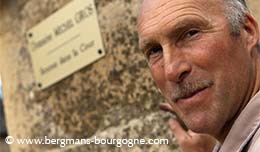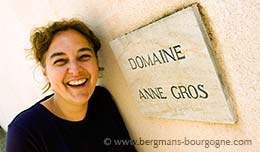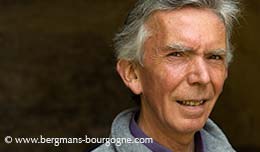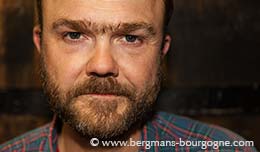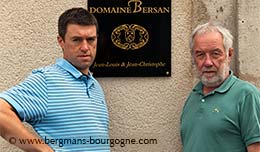
or me the fermentation is the best part of this profession. It’s the end of a year’s work in the vineyards and it’s the beginning of the wine. It’s simply beautiful.
Stéphan Podor in Irancy decided to become a winegrower, against his parents’ wishes. That was back in 1989 and he has never regretted his choice. Today he runs Domaine Podor with close to ten hectares of vines around the village.
 – When I was 15-16 years old I spent a lot of time with my wine growing cousin Jean. My parents were not winegrowers themselves, but they had seen previous generations. It was a tough life. Back then, being a winegrower was not only having vineyards and making wine. In order to make a living you also had to grow cereals or to keep cows. Wine was just one part of your job. Very little was bottled and most of the wine was sold in the area.
– When I was 15-16 years old I spent a lot of time with my wine growing cousin Jean. My parents were not winegrowers themselves, but they had seen previous generations. It was a tough life. Back then, being a winegrower was not only having vineyards and making wine. In order to make a living you also had to grow cereals or to keep cows. Wine was just one part of your job. Very little was bottled and most of the wine was sold in the area.
After wine school in Beaune Stéphan Podor worked for his cousin Jean Podor in 1988 and the acquired two hectares of vines from a retiring grower the following year. Later the domaine grew to cover four and a half hectares. He describes himself as a somebody who makes wine the way it was made 50 years ago.
 – I have no wish for modern winemaking, with oenologue and everything, he says. You’ll never find an oenologue here. In a modern winery much is hidden. I want to be able to see and smell the fermentation. I have colleagues who never look at the wines during fermentation. That is not how I want it.
– I have no wish for modern winemaking, with oenologue and everything, he says. You’ll never find an oenologue here. In a modern winery much is hidden. I want to be able to see and smell the fermentation. I have colleagues who never look at the wines during fermentation. That is not how I want it.
Originally from Hungary the Podor family arrived in Irancy in 1650. They were shoemakers, but later became winegrowers. Stéphan Podor is the eighth generation to make wine, even though his parents chose not to.
 – My grandfather was a winegrower. His last vintage was in 1977. When he stopped my cousin Jean took on his vineyards. The Podor family has always been in Irancy.
– My grandfather was a winegrower. His last vintage was in 1977. When he stopped my cousin Jean took on his vineyards. The Podor family has always been in Irancy.
When Jean Podor, having no children, retired in 2000 the vineyards were passed on to Stéphan Podor.
– Close to ten hectares is about as much as I can handle, says Stéphan Podor.
Irancy is a 20-minute drive southwest of Chablis. It is an all red appellation, which received its village appellation status in 1999. You’ll find most of the vineyards on the slopes of the giant amphitheatre that surrounds the village. Some of the vineyards spill over into the neighbouring villages of Vincelottes and Cravant.
 This is also the home of one of Burgundy’s exceptions – the césar grape. The rules for the Irancy appellation allow up to ten per cent of césar to be blended with the pinot noir. Not all growers do that. Some make their Irancy without any césar. Stéphan Podor uses five per cent for his cuvées.
This is also the home of one of Burgundy’s exceptions – the césar grape. The rules for the Irancy appellation allow up to ten per cent of césar to be blended with the pinot noir. Not all growers do that. Some make their Irancy without any césar. Stéphan Podor uses five per cent for his cuvées.
– There is not much, but there has always been a bit of césar in Irancy, says Stéphan Podor. The monks brought it here for the tannins. The finesse, that’s the pinot noir. The césar also adds colour. An Irancy with césar stays red when it ages. But you shouldn’t add too much.
 – The young growers are not very fond of the césar because it is an unpredictable variety. It lowers the alcohol level. The grapes are big, which means lots of juice and not so much sugar. The césar produces big bunches, not exactly what you are looking for in Burgundy.
– The young growers are not very fond of the césar because it is an unpredictable variety. It lowers the alcohol level. The grapes are big, which means lots of juice and not so much sugar. The césar produces big bunches, not exactly what you are looking for in Burgundy.
– But if you just add the right amount of césar you will get a very nice result. It will add some tannins and a peppery touch to the taste.
The césar is not grown, harvested or vinified separately. In the vineyard the césar vines are planted among the pinot noir vines, automatically creating a 5-95 blend.
– My vines are old. About 80 years old. So I don’t have much of a choice. The césar is there. With césar involved you have to keep the vinification short. I only do eight to ten days. I harvest by hand and I use whole bunches. Modern winemaking techniques, like long maceration, does not work with the césar. I vinify the way many did 50 years ago.
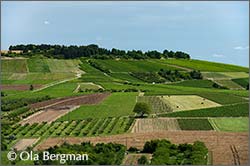 Part of the production at Domaine Podor is destined for the cooperative in nearby Bailly, a hamlet to Saint-Bris-le-Vineux. Part ends up at Domaine Jean-Louis & Jean-Christophe Bersan, who buys grapes for their Irancy. The rest is bottled and sold by Stéphan Podor.
Part of the production at Domaine Podor is destined for the cooperative in nearby Bailly, a hamlet to Saint-Bris-le-Vineux. Part ends up at Domaine Jean-Louis & Jean-Christophe Bersan, who buys grapes for their Irancy. The rest is bottled and sold by Stéphan Podor.
He makes three Irancy cuvées – one blend from various lieux-dits and two cuvées from specific vineyards, Les Mazelots and Palotte. Les Mazelots is the slope to the immediate northeast of the village, while Palotte is south of the village, just across the border to Cravant. The Irancy blend is vinified in tank, the other two in barrels.
– The vines in Les Mazelots were planted in 1936, says Stéphan Podor. It is not fined or filtered. I buy barrels second hand in the Côte d’Or, barrels which have been used for two wines. Irancy is not Gevrey-Chambertin. Irancy is lighter, which means you have to have used barrels. The barrels come from a friend in Gevrey-Chambertin, Domaine Rossignol-Trapet. Les Mazelots needs to be kept for a while. Three or four years in bottle will soften the tannins.
– Palotte was planted much later, in 1978. This and the fact that it is a very different terroir makes it very different from Les Mazelots. But both wines are vinified the same way.
– In general Irancy can be described as cherries on the nose and liquorice on the palate.
© 2017 Ola Bergman










